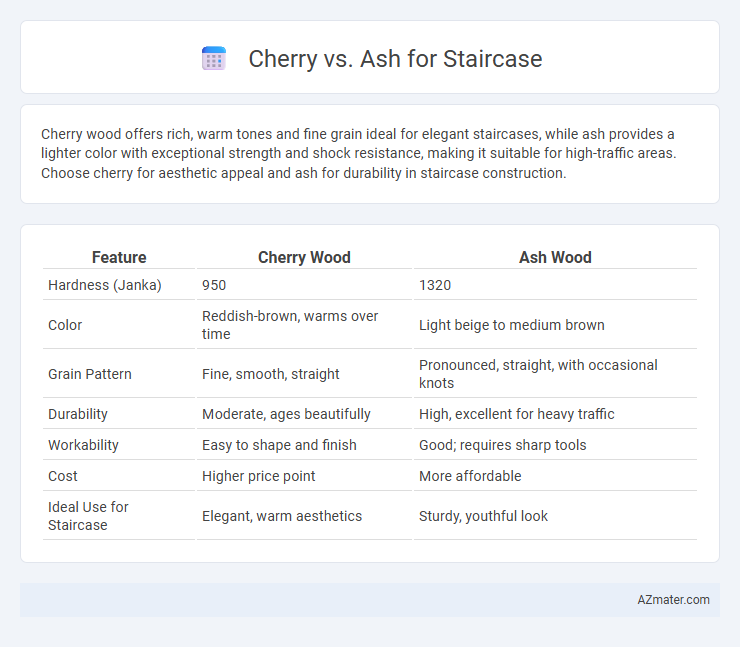Cherry wood offers rich, warm tones and fine grain ideal for elegant staircases, while ash provides a lighter color with exceptional strength and shock resistance, making it suitable for high-traffic areas. Choose cherry for aesthetic appeal and ash for durability in staircase construction.
Table of Comparison
| Feature | Cherry Wood | Ash Wood |
|---|---|---|
| Hardness (Janka) | 950 | 1320 |
| Color | Reddish-brown, warms over time | Light beige to medium brown |
| Grain Pattern | Fine, smooth, straight | Pronounced, straight, with occasional knots |
| Durability | Moderate, ages beautifully | High, excellent for heavy traffic |
| Workability | Easy to shape and finish | Good; requires sharp tools |
| Cost | Higher price point | More affordable |
| Ideal Use for Staircase | Elegant, warm aesthetics | Sturdy, youthful look |
Introduction to Cherry and Ash Woods
Cherry wood, prized for its rich reddish-brown color and smooth grain, offers durability and a warm aesthetic ideal for elegant staircase designs. Ash wood features a pale, creamy appearance with a prominent straight grain, providing exceptional strength and shock resistance well-suited for high-traffic staircases. Both woods balance beauty and functionality, but cherry emphasizes refined elegance while ash excels in robustness and lightness.
Overview of Staircase Wood Selection
Cherry wood offers rich reddish hues and smooth grain, creating a warm and elegant appearance for staircases, while Ash provides a lighter color with distinct grain patterns that promote a modern and durable finish. Both woods boast excellent hardness and stability, crucial for the high-traffic nature of staircases, but Ash tends to resist dents and wear better due to its higher Janka hardness rating. Selecting between Cherry and Ash depends on aesthetic preferences and desired durability, with Cherry appealing to classic designs and Ash preferred for contemporary, robust applications.
Appearance: Cherry vs Ash Grain and Color
Cherry wood exhibits a rich, warm reddish-brown hue that deepens with age, featuring a fine, smooth grain with subtle waves, ideal for elegant staircase aesthetics. Ash offers a lighter, creamy to pale brown color with a pronounced, straight grain pattern that provides a clean, contemporary look for staircases. Both woods develop distinct patinas over time, with Cherry becoming darker and Ash maintaining a brighter, more uniform appearance.
Durability and Hardness Comparison
Cherry wood offers moderate durability with a Janka hardness rating of approximately 950, making it suitable for staircases with light to moderate foot traffic. Ash wood, known for its exceptional strength, has a higher Janka hardness of about 1,320, providing superior resistance to dents and wear, ideal for high-traffic staircases. When prioritizing durability and hardness, ash outperforms cherry, ensuring longer-lasting staircases that withstand heavy usage.
Workability and Ease of Installation
Cherry wood offers excellent workability due to its fine, straight grain and uniform texture, making it easy to shape and sand for intricate staircase details. Ash, known for its strength and elasticity, provides a balance of workability and durability, allowing for smooth cutting and shaping without splintering. Both woods facilitate ease of installation, but Ash's hardness provides superior resistance to wear, ideal for high-traffic staircase areas.
Cost Differences: Cherry vs Ash Staircases
Cherry staircases typically cost more than ash due to the wood's rich color, fine grain, and slower growth rate, making it a premium hardwood option. Ash wood offers a more budget-friendly solution with its lighter color and durable, flexible properties, providing excellent value for staircases. Choosing between cherry and ash depends on balancing aesthetic preferences with project budget constraints.
Maintenance and Longevity
Cherry wood offers moderate maintenance, requiring regular polishing to preserve its rich, warm hue and prevent surface wear, while ash wood demands less frequent upkeep due to its natural resistance to dents and scratches. Ash staircases typically exhibit superior longevity, maintaining structural integrity and appearance for decades even in high-traffic areas, whereas cherry can show signs of aging through darkening and minor surface imperfections over time. Both woods benefit from controlled indoor humidity to minimize warping, but ash's durability and easier maintenance make it a preferred choice for long-lasting staircases.
Environmental Impact and Sustainability
Cherry wood offers moderate sustainability with a slower growth rate, making it less renewable compared to Ash, which is a faster-growing hardwood known for its environmental benefits. Ash trees replenish more quickly, reducing deforestation risks and promoting eco-friendly harvesting for staircase construction. Both woods are durable, but choosing Ash supports better environmental impact due to its higher renewability and lower carbon footprint during growth.
Design Flexibility and Style Compatibility
Cherry wood offers rich, warm tones and fine grain patterns that enhance traditional and classic staircase designs, providing excellent design flexibility for ornate balusters and curved handrails. Ash wood features a lighter color palette and a straight grain, making it highly compatible with modern and minimalist styles while maintaining strength for structural elements. Both woods allow customization through staining and finishing, but Cherry's natural aging process adds depth over time, ideal for timeless aesthetics.
Choosing the Best Wood: Cherry or Ash for Your Stairs
Cherry wood offers rich, warm tones and smooth grain patterns that enhance the elegance of staircases, while Ash provides superior durability and a lighter, more contemporary appearance ideal for high-traffic areas. Ash's hardness and shock resistance make it an excellent choice for stair treads, ensuring longevity under heavy use, whereas Cherry's natural aging process results in a deepening patina that adds character over time. Selecting between Cherry and Ash depends on balancing aesthetic preferences for warmth versus brightness with functional priorities like wear resistance and maintenance.

Infographic: Cherry vs Ash for Staircase
 azmater.com
azmater.com